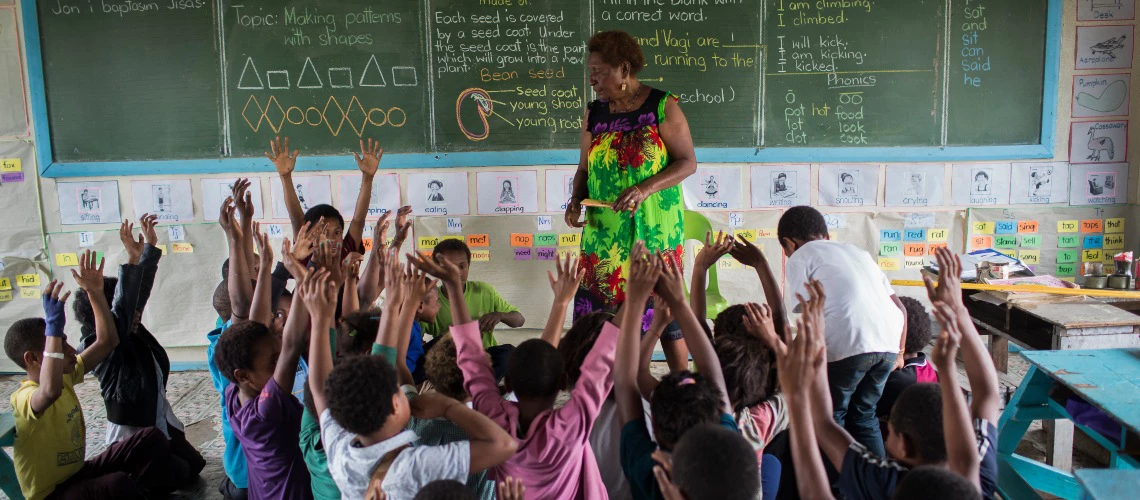 Ensuring that teacher policies are operationally feasible and politically acceptable is essential to transform learning. Copyright: Conor Ashleigh/World Bank
Ensuring that teacher policies are operationally feasible and politically acceptable is essential to transform learning. Copyright: Conor Ashleigh/World Bank
Like in many areas of public policy, teacher policy interventions often succeed in small-scale pilots but fail to achieve sustained, system-level changes when implemented at scale. Economist John List coined the term “voltage drop” to convey the widely observed fact that many interventions yield lower impacts when they scale. For instance, teacher coaching interventions are roughly half as effective, on average, when they move from pilots to scale (Figure 1).
Figure 1. Effect sizes of teacher coaching interventions of varying scales on teaching practices and learning

Source: Based on Kraft, Blazar, and Hogan (2018). Note: “Small programs” cover less than 100 teachers, while “large programs” cover over 100 teachers.
In our recent World Bank report, Making Teacher Policy Work, we examine this question: Why, despite the growing evidence on effective teacher policies, do we not observe high-quality teaching and learning in every classroom and every school?
We argue that teacher policies often do not succeed at scale because their design and implementation fail to consider the individual and system-level barriers that prevent teachers from adopting the changes envisioned by the policy in ways that are scalable and sustained (Figure 2). This blog focuses on how teacher policy reforms can overcome system-level barriers to scalable and long-lasting change. As a first step, policymakers should ask themselves: Is the policy operationally feasible? Is it politically acceptable? How can we use data to steer change?
Figure 2. Key elements to make teacher policies work at scale and sustainably

Source: World Bank (2023). Making Teacher Policy Work.
Are resources and management capacity adequate to implement the teacher policy at scale and over time?
Teacher policies require adequate funding, the essential inputs, and management capacity to deploy and sustain at scale. For example, Kraft, Blazar, and Hogan found that the voltage drop in the impacts of teacher coaching programs stems in part from the inability to secure sufficient qualified coaches and the buy-in of teachers for at-scale implementation.
Competent management is needed to deploy teacher policy that involves thousands of schools, students, and teachers in a school system. For instance, in 2005, Indonesia enacted the ambitious Teacher and Lecturer Law to improve teaching quality. Despite a sound policy design, implementation faced setbacks due to inadequate staffing to assess teacher competencies at scale. This and delayed funding for teacher training undermined the goal of strengthening teacher professional development and the reform failed to improve student learning nationwide. Indonesia has since adopted a gradual approach with its latest Merdeka Belajar (Emancipated Learning) reform to build adequate capacity to implement effectively at scale.
Is there political commitment, trust, and coalitions to ensure that the teacher policy can be scaled and preserved over time?
A strong political commitment is a prerequisite for the scalability and sustainability of teacher policies. Teacher reforms unfold in complex political systems involving multiple stakeholders, including students, teachers, administrators, and parents. Clear, ambitious, yet attainable education goals communicated broadly can signal high-level political commitment and facilitate alignment among stakeholders. Building coalitions of stakeholders, including those with veto power over policies, is essential. Trust between teachers, teacher unions, and the government fosters inter-temporal cooperation. Compromises, sequencing, and bundling of policies are often necessary to obtain buy-in from different groups.
For example, the teacher policy reforms in Delhi, India, after 2015, and Peru's 2013 education teacher reforms were spurred through active engagement with teachers and unions, wide public communication campaigns to underscore the crucial role of teachers and the engagement of parents and other change agents. In 2022, Chile’s teacher reforms started with voluntary teacher evaluations and only made them mandatory after several years of implementation to demonstrate the policy's benefits. This led to sustained buy-in for mandatory teacher assessments over many years.
Are there adequate data and systems to prioritize and adapt the policy?
Scaling up a teacher policy reform without data is like navigating without a map: policymakers may not know where or how to start to tackle the binding operational and political constraints they face. Data allows policymakers to course-correct, stretch management capacities and steer change by tracking and communicating progress, thereby aligning stakeholders with the ultimate goal of student learning. For example, the development of the "Teaching at the Right Level" (TaRL) initiative in India has relied on classroom data on learning and teaching practices to drive adjustments over a decade that culminated in one of the most cost-effective at-scale teacher policies to date.
Scaling and sustaining teacher policy reforms
The municipality of Sobral and the State of Ceará, in Brazil, exemplify how reforms that address individual and system-level barriers to change can lead to sustained educational transformation. Sobral covers about 11,500 students in primary education in about 34 schools and 350 teachers. In 1997, about 40 percent of grade 3 students in Sobral could not read a sentence. Through teacher-focused policy reforms (examined in upcoming blogs), by 2015, Sobral achieved nearly universal functional literacy and topped the ranking of basic education quality in Brazil. This inspired Ceará to roll out similar policy changes state-wide to reach about 485,000 primary education students in 3,600 schools and 24,000 teachers. All Ceara municipalities improved education quality, some even surpassing Sobral (Figure 3).
Figure 3. Sobral and Ceará’s transformation in primary education in Brazil (Grades 1 to 5), 2005 - 2021

Source: World Bank (2023). Updated from Loureiro, and Cruz (2020) with data from ideb.inep.gov.br.
The key to the scaling up of teacher reforms in Sobral and Ceará was an unwavering political commitment to secure adequate resources, built capacity, trust, and coalitions, and a data-driven approach to steer change. This experience underscores that ensuring that teacher policies are operationally feasible and politically acceptable is essential to transform learning in every school and every classroom.
To learn more:
· Read the Making Teacher Policy Work report and watch the report launch event.
· For a quick introduction to the report, check out the two-pager, also available in Arabic, French, Portuguese, and Spanish.
· For more on the World Bank’s strategy on teachers, see “Successful Teachers, Successful Students: Recruiting and Supporting Society’s Most Crucial Profession”
· To learn more about the World Bank’s Teach program to measure effective teaching practices through classroom observation, see the Teach briefs and tools.
· To learn more about the World Bank’s Coach program to improve in-service teacher professional development, visit the Coach website, take a look at the Coach tools and resources.




Join the Conversation